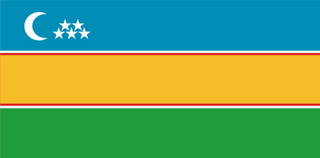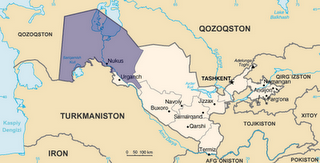 Last week, the Russian oil company Lukoil announced to have coaxed the first natural gas out of its South West Gissar development in Uzbekistan. The production came from the Dzharkuduk-Yangi Kyzylcha field, part of the Kashkadarya Region in the southern part of the country. Like Kazakhstan and Turkmenistan, Uzbekistan is a dry but energy-rich country: export of hydrocarbons provided about 40% of foreign exchange earnings in 2009. One of the regions with the largest estimated reserves of fossil fuels is the autonomous republic of Karakalpakstan, which occupies the western part of Uzbekistan.
Last week, the Russian oil company Lukoil announced to have coaxed the first natural gas out of its South West Gissar development in Uzbekistan. The production came from the Dzharkuduk-Yangi Kyzylcha field, part of the Kashkadarya Region in the southern part of the country. Like Kazakhstan and Turkmenistan, Uzbekistan is a dry but energy-rich country: export of hydrocarbons provided about 40% of foreign exchange earnings in 2009. One of the regions with the largest estimated reserves of fossil fuels is the autonomous republic of Karakalpakstan, which occupies the western part of Uzbekistan. The discovery of major Karakalpak gas fields on the central U’stirt plateau and under the bed of the Aral Sea during the 1990’s has led the Uzbek government to the recognition of the region as the number one national priority for future investment in gas field development and production. According to some estimates, Karakalpakstan’s natural-resources wealth could amount to 1.7 trillion cubic metres of natural gas and 1.7 billion tonnes of oil. Nevertheless, such developments may soon pose a threat to Uzbekistan’s national unity, as they are actually fueling a revival of separatist sentiments among Karakalpaks.
Karakalpaks are closer ethnically and linguistically to Kazakhs than to Uzbeks, and some claim that the Karakalpak ethnic group was a Soviet invention aimed at dividing up the Kazakh population, in line with the principle of “divide and rule” used by Moscow in other circumstances, such as the transfer of South Ossetia and Abkhazia to the Georgian Soviet Socialist Republic and the inclusion of the Armenian territory of Nagorno-Karabakh into the Azerbaijan Soviet Socialist Republic. As for the creation of the five republics of Central Asia, the map of Karakalpakstan was drew up by Soviet leader Joseph Stalin in the 1920s. Founded as an autonomous region in 1925, Karakalpakstan changed its status in 1932 to become an autonomous republic. In 1936, it eventually became part of Uzbekistan, constituting 37 percent of its territory.
Separatist sentiments were first voiced in Karakalpakstan in the mid-1980s, as calls for sovereignty and independence spread throughout the Soviet republics. In December 1990, the Supreme Council of the Karakalpak Autonomous Soviet Socialist Republic adopted a “Declaration on State Sovereignty.” It included the prospect of independence from the Uzbek Soviet Socialist Republic and even the Soviet Union if such a move was approved by Karakalpak citizens in a referendum. The first constitution of Karakalpakstan was adopted in April 1993 and stipulated a similar possibility, while Article 74 of the Uzbek constitution itself states that “The Republic of Karakalpakstan has the right to secede from the Republic of Uzbekistan on the basis of a referendum held by the people of Karakalpakstan.”
Although theoretically possible, a peaceful Karakalpakstan’s independence from Tashkent appears unlikely, since the Uzbek parliament must consent to the holding of any referendum, and the Uzbek President Islam Karimov has been very careful in the choice of leaders appointed to rule the republic. Furthermore, Karakalpaks are the fifth-largest ethnic group in Uzbekistan, representing just a 2.5 percent of the country’s 28 million people. Within the autonomous republic itself, ethnic Karakalpaks make up less than a half of the total population of 1.2 million people.
Nevertheless, the political situation in Karakalpakstan may rapidly deteriorate, as problems faced by the entire population of the republic are severe. Karakalpakstan has high rates of tuberculosis and other diseases whose outbreaks are ascribed at least in part to environmental problems related to the disappearance of the Aral Sea, which has shrunk by two-thirds in the last 60 years as agriculture and other projects divert the precious Amu Darya River. The sea was also used for biological-weapons testing during the Soviet era, and a nearly fivefold increase in salinity has already killed most of the region’s natural flora and fauna. As a result of poor living conditions, in recent years some 200,000 Karakalpaks have been forced to move to Kazakhstan, taking advantage of Astana’s “Oralman” policy, which is meant to return people to their ethnic homeland.
MAP OF KARAKALPAKSTAN
 The destiny of Karakalpakstan is therefore likely to produce consequences on a regional scale. If the exploitation of the republic’s underground resources by Tashkent will not be accompanied by an improvement in the local standards of living, the eruption of an independence conflict would be an eventuality far from remote. At that point, Astana may use the aspirations for independence of Karakalpaks to increase its influence in Central Asia at the expense of its traditional rival Uzbekistan, thereby writing an unpublished chapter in the long, bloody history of the geopolitical struggle known as the “Great Game”.
The destiny of Karakalpakstan is therefore likely to produce consequences on a regional scale. If the exploitation of the republic’s underground resources by Tashkent will not be accompanied by an improvement in the local standards of living, the eruption of an independence conflict would be an eventuality far from remote. At that point, Astana may use the aspirations for independence of Karakalpaks to increase its influence in Central Asia at the expense of its traditional rival Uzbekistan, thereby writing an unpublished chapter in the long, bloody history of the geopolitical struggle known as the “Great Game”.

